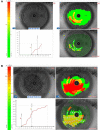Changes in Noncontact Meibography and Noninvasive Tear Break-Up Time Test with Contact Lenses Usage
- PMID: 35547400
- PMCID: PMC9084505
- DOI: 10.2147/OPTH.S362307
Changes in Noncontact Meibography and Noninvasive Tear Break-Up Time Test with Contact Lenses Usage
Abstract
Purpose: The study aimed to determine changes detected by noncontact meibography and noninvasive break-up time test (NIBUT) in individuals with regular use of soft contact lenses and compare these findings with irregular soft contact lenses wearers who not compliant with them and non-wearers control group.
Patients and methods: A prospective nonrandomized case-control study in which individuals were recruited and distributed into three groups: Group A (regular contact lens wearers), group B (irregular contact lens wearers), and group C (non-wearers). Ocular Surface Disease Index (OSDI) was obtained. Noncontact meibography and noninvasive tear break-up time were measured without lenses on using Sirius® Scheimpflug Camera.
Results: One hundred sixty-six eyes of 83 individuals were included; 36 eyes in group A, 50 eyes in group B, and 80 eyes in group C. The mean total meiboscore was 1.99, 1.61, and 1.28, respectively. The mean meibograde was 3.03, 2.86, and 1.99, respectively. Noninvasive break-up time (NIF-BUT) was 8.42, 11.76, and 13.57 seconds, respectively.
Conclusion: There is a difference in OSDI score, meibomian score, and break-up time between different study groups. The study results show that there are trends in lens wearers and non-lens wearers. This is useful for the field to understand the differences between lens wearers and non-lens wearers.
Keywords: noncontact meibography; noninvasive break-up time; soft contact lenses.
© 2022 Fattoh et al.
Conflict of interest statement
The authors have no financial or proprietary interest in the product, method, or material described herein. The authors declare that they have no conflicts of interest for this work.
Figures



Similar articles
-
Associations with meibomian gland loss in soft and rigid contact lens wearers.Cont Lens Anterior Eye. 2022 Feb;45(1):101400. doi: 10.1016/j.clae.2020.12.005. Epub 2021 Jan 7. Cont Lens Anterior Eye. 2022. PMID: 33422424
-
Meibomian glands structure in daily disposable soft contact lens wearers: a one-year follow-up study.Ophthalmic Physiol Opt. 2020 Sep;40(5):607-616. doi: 10.1111/opo.12720. Epub 2020 Jul 27. Ophthalmic Physiol Opt. 2020. PMID: 32716128
-
Association of contact lens-related allergic conjunctivitis with changes in the morphology of meibomian glands.Jpn J Ophthalmol. 2012 Jan;56(1):14-9. doi: 10.1007/s10384-011-0103-6. Epub 2011 Nov 23. Jpn J Ophthalmol. 2012. PMID: 22109632
-
Meibomian Gland Dropout, not Distortion, Can Distinguish Dry Eyes from Normal Eyes in Contact Lens Wearers.Curr Eye Res. 2020 Aug;45(8):897-903. doi: 10.1080/02713683.2020.1731829. Epub 2020 Mar 2. Curr Eye Res. 2020. PMID: 32066267 Review.
-
Tear analysis in contact lens wearers.Trans Am Ophthalmol Soc. 1985;83:501-45. Trans Am Ophthalmol Soc. 1985. PMID: 3914131 Free PMC article. Review.
Cited by
-
Face Mask and Tear Film Stability: A Pilot Study of the Objective Measurement of Tear Break-Up Time.J Clin Med. 2023 Dec 16;12(24):7727. doi: 10.3390/jcm12247727. J Clin Med. 2023. PMID: 38137796 Free PMC article.
-
Comparing automated and manual assessments of tear break-up time using different non-invasive devices and a fluorescein procedure.Sci Rep. 2024 Jan 30;14(1):2516. doi: 10.1038/s41598-024-52686-0. Sci Rep. 2024. PMID: 38291100 Free PMC article. Clinical Trial.
-
Non-contact meibography changes according to disease activity in rheumatoid arthritis cases.BMC Ophthalmol. 2023 Nov 13;23(1):454. doi: 10.1186/s12886-023-03194-8. BMC Ophthalmol. 2023. PMID: 37957641 Free PMC article.
References
-
- Kim YH, Nguyen T, Lin MC, et al. Protection against corneal hyperosmolarity with soft-contact-lens wear [published online ahead of print, 2021 Sep 29]. Prog Retin Eye Res. 2021;4:101012. - PubMed
LinkOut - more resources
Full Text Sources

